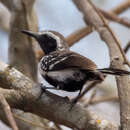en
names in breadcrumbs


The northern white-fringed antwren (Formicivora intermedia) is an insectivorous bird in the antbird family Thamnophilidae. It is a resident breeder in tropical South America and occurs in northern Colombia, northern Venezuela and on the islands of Tobago and Margarita.
The German ornithologist Jean Cabanis described the northern white-fringed antwren in 1847 and coined its current binomial name Formicivora intermedia.[2] It was formerly considered conspecific with the southern white-fringed antwren (Formicivora grisea) but is now often treated as a separate species based on the difference in vocalization.[3][4]
There are six subspecies:[5]
The northern white-fringed antwren is 12–13 cm (4.7–5.1 in) long, and weighs 9–12 g (0.32–0.42 oz). The male of the nominate subspecies has grayish brown upperparts, a blackish tail and blackish wings with white spots on the coverts and a white bar. A white supercilium extends as a broad stripe down the side of the breast and body. The underparts are black. The female has upperparts similar to that of the male but the underparts are buff with darker spots or streaking on the breast.[6]
The northern white-fringed antwren (Formicivora intermedia) is an insectivorous bird in the antbird family Thamnophilidae. It is a resident breeder in tropical South America and occurs in northern Colombia, northern Venezuela and on the islands of Tobago and Margarita.